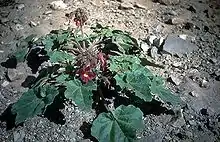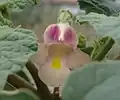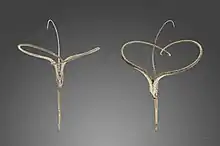| Proboscidea | |
|---|---|
 | |
| Proboscidea louisianica | |
| Scientific classification | |
| Kingdom: | Plantae |
| Clade: | Tracheophytes |
| Clade: | Angiosperms |
| Clade: | Eudicots |
| Clade: | Asterids |
| Order: | Lamiales |
| Family: | Martyniaceae |
| Genus: | Proboscidea Schmidel |
| Species | |
|
See text | |
Proboscidea is a genus of flowering plant in the family Martyniaceae, some of whose species are known as devil's claw, devil's horn, ram's horn, or unicorn plant. The plants produce long, hooked seed pods. The hooks catch on the feet of animals, and as the animals walk, the pods are ground or crushed open, dispersing the seeds. The name devil's claw is shared with the South African plant Harpagophytum procumbens.
Uses

The fruits of all species are edible before they ripen and become woody. They can be steamed and eaten much like okra. Some species (particularly P. parviflora) are used in basket weaving by the Tohono O'odham who have selected for varieties with longer "claws."[1] The Chemehuevi also use devil's claw pods in basketry.[2] The Hia C-eḍ Oʼodham and the Tohono O'odham eat the seeds, which provided an important source of dietary oils. P. parviflora was also used as a remedy for rheumatism.[3]
Species
Species include:
- Proboscidea althaeifolia - devil's horn, devil's claw, or desert unicorn plant
- Proboscidea louisianica - ram's horn
- Proboscidea parviflora - doubleclaw, (red) devil's claw
- Proboscidea sabulosa - dune unicorn plant
- Proboscidea spicata - New Mexico unicorn plant
Proboscidea lutea is a synonym of Ibicella lutea.
 P. louisianica
P. louisianica.jpg.webp) P. louisianica ssp. fragans
P. louisianica ssp. fragans P. parviflora
P. parviflora Flower of P. parviflora ssp. parviflora var. hohokamiana[1]
Flower of P. parviflora ssp. parviflora var. hohokamiana[1] "Devil's claw" fruits of P. parviflora var. hohokamiana
"Devil's claw" fruits of P. parviflora var. hohokamiana "Devil's claw" capsule of Proboscidea althaeifolia
"Devil's claw" capsule of Proboscidea althaeifolia "Devil's claw" seeds of Proboscidea althaeifolia
"Devil's claw" seeds of Proboscidea althaeifolia

References
- 1 2 "Devils Claws". waynesword.palomar.edu. Archived from the original on 19 February 2008. Retrieved 18 March 2018.
- ↑ "Basket Jar". Metropolitan Museum of Art. 2020.
- ↑ "BRIT - Native American Ethnobotany Database". naeb.brit.org. Retrieved 2022-09-22.